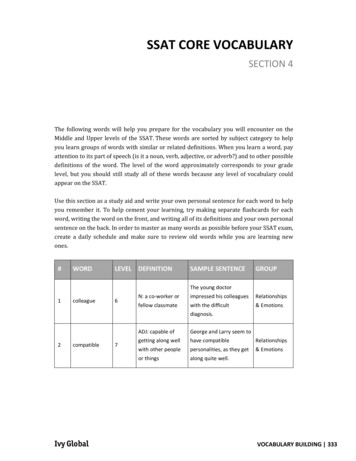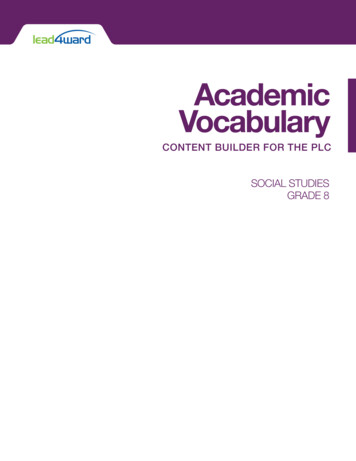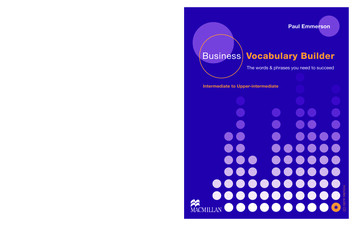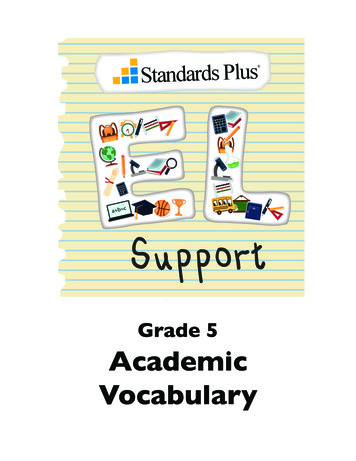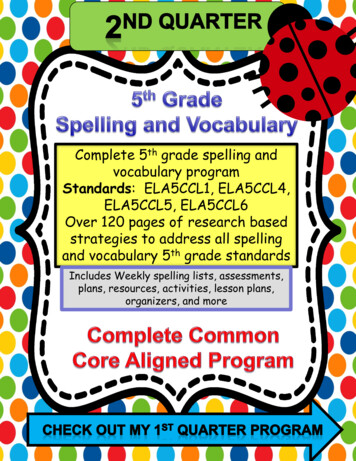
Transcription
Standards Plus Su pp or tGrade 8AcademicVocabulary
What is Academic Vocabulary?Academic Vocabulary includes the words, phrases, and language structures thatare used in learning. It includes the formal language that is used in education,whether orally, in textbooks, and in assessments.Academic Vocabulary is distinct from the informal language that is used at home,on the playground, and in daily conversation. Slang and colloquialisms are not partof academic vocabulary. Students may be quite adept with the English languagein the informal register long before the academic register is developed. It takesspecific instruction to build academic vocabulary.2www.standardsplus.org 2011 Learning Plus Associates
5th Grade Mathematics TeachingAcademic VocabularyLesson Index with Language ObjectivesThere are three methods of teaching academic vocabulary, and all three are necessary forvocabulary development. Explicit instruction of words, explicit instruction ofword-learning strategies, and indirect instruction of vocabulary are all essential to developing academic vocabulary.In explicit instruction of words, teachers select terms that are taught using definitions,examples, and proper usage. These terms may be content-specific (e.g., addend, subtrahend)or conceptual (e.g., summarize, explain). This instruction includes using the terms in contextand multiple exposures to cement the learning. If word banks or vocabulary notebooks areused, these are the terms that are included with definitions, usage, and non-linguistic representations to help the learner remember the term and its meaning and usage.In explicit instruction of word-learning strategies, teachers introduce, model, and prompt for the use of strategies that are used when a student comes to an unknown word. Context clues, word parts, cognates, text features, and related words are usedto help the student attach meaning to the unknown word. Students must practice usingthe strategies across the curriculum whenever they are presented with unknown words.For the English Learner, special attention must be given to helping him determine which arethe important words. Names and poetic or flowery description can be difficult to navigate,but may not be essential for comprehension of the big ideas being presented.In indirect instruction of vocabulary, students are exposed to language through discussion, reading, being read to, multimedia resources, and education-related experiences. Thisis a very natural way to learn language, but it also varies widely depending on the languageexperience of the student.www.standardsplus.org 2011 Learning Plus Associates3
Reinforcing Academic Vocabulary InstructionStudents should record terms that are taught directly. The record of the terms should be ina format that the student can easily access and understand. The vocabulary may be collectedin a notebook, on note cards, in word banks, or other collections, but they must have meaningfor the student. If each student has an individual record of the terms, leave room for newinformation. Students should add new concepts, deeper meaning, graphics, or new usages tothe record as the vocabulary develops.When a term is revisited or a new or deeper meaning is explored, the students should beprompted to record the new learning. Students may also use graphic organizers to help themsee the connections between related terms. This is especially helpful when studying a topicwith many academic vocabulary terms. The Standards Plus EL Portal has manygraphic organizers that can be used. Each graphic organizer is presented in a blankformat and a completed format as an example of how it may be used: Concept webConcept treeVenn diagramOrganized ListIdea handGames are an engaging way to revisit vocabulary, and a few simple games can be used all yearwith different sets of vocabulary. Vocabulary Bingo can be set up so that the students listenfor vocabulary terms or their definitions. The bingo cards may have a different term writtenin each square, or they may have a different definition in each square. The teacher can callthe definition of the term, and the students must mark the matching term, or the teachermay call the term itself, and the students must mark the definition that goes with the term.Examples of these two types of bingo games are found in the StandardsPlus EL Portal . Charades or picture charades work well for terms that can be acted outor drawn. Crossword puzzles and rebuses are great for review, too.4www.standardsplus.org 2011 Learning Plus Associates
Reinforcing Academic Vocabulary InstructionIn the spirit of competition, students can compete for class, table, or personal “points” for finding or using academic vocabulary. For example, a student may come in from the playgroundand say, “Wow! A lot happened at lunch today. Let me summarize what happened ”If summarize is a term that the class is studying, the class, that student’s table group, or thestudent could earn a “point” for correct usage of an academic vocabulary term. Students mayalso earn points for finding academic vocabulary terms in reading material, hearing academicvocabulary terms that others use, or using them in their writing.www.standardsplus.org 2011 Learning Plus Associates5
Grade 8Language Arts - Academic VocabularyAAbbreviations: A shortening of a word to stand for the word (e.g., mister – Mr.).Acronym: The first letters of words in a phrase (e.g.,ASAP – as soon as possible).Active Voice: Emphasizes the actor or doer of the action; the subject of the sentence performs theaction.Affix: a word part that is added to the beginning or end of a root.Allusion: A reference (explicit or indirect) to a person, place, or event, or to another literary workor passage.Analogy: A comparison between two things that are similar in some way, often used to help explain something or to make it easier to understand; a figure of speech that shows the relationshipbetween words or ideas.Argument: an established claim that is proven through logical reasoning, examples, and research.Authorities: Experts identified by name and having credentials.Author’s purpose: the reason an author writes a text.BBackground information: information related to the claim that helps to orient the reader.CCharacter: a person in the story.Characters: People in a story.Chronological: a text structure that uses time order.Circumstance: The situation of an occurrence.Claim: the writer’s position on a problem or issue.Classification: A text structure in which the author arranges people, objects, or ideas according toshared characteristics.Closing: The last line before the signature in a letter (e.g., Sincerely,).Colloquial Language: Language that fits the time, region, and speech patterns of the characters.Comparison: making connections through showing similarities and differences.6www.standardsplus.org 2011 Learning Plus Associates
Grade 8Language Arts - Academic VocabularyComplex sentence: A sentence with one or more dependent clauses, and one independent clause.There is a comma after the dependent clause if it precedes the independent clause.Compound sentence: A sentence with two or more independent clauses, often connected with acoordinating conjunction.Concluding paragraph – Argument: The final paragraph that restates the claim and ties togetherthe reasons that support the claim. Often the conclusion of an argument will appeal to the readerto agree with the claim.Concluding Sentence: The sentence that summarizes the main idea of the paragraph or essay.Concluding words and phrases: Words and phrases that sum up ideas in a written text (e.g., inconclusion, as you can see, as a result).Conclusion: How the story ends.Conclusion – Informative/Explanatory: The final sentence or paragraph that restates the topic andlets the reader know that the text is complete.Concrete detail: An object or event that can be experienced with one’s senses.Conditional Mood: Indicates a conditional state that will cause something else to happen. It ismarked by the modal verbs might, could, and would.Conflict: the central concern or problem in the story.Connotation: the implied or associated feeling of a word or words: neutral, positive, or negative.Context: information that supports the claim; also called evidence; the words and ideas that surround a word and provide clues to its meaning.Contraction: The shortening of a word or phrase by omission of a letter or letters. An apostropheis used to show where the letter or letters have been omitted.Counterclaim: A claim that is in opposition to the argument.DDash: A line (—) that is used to indicate a pause or break in thought.Definition: Brief, precise statement of what a word or expression means; the act of stating something clearly.Denotation: the literal meaning of a word.Descriptive: Describes the world surrounding the speaker/author with elaborate imagery andadjectives.www.standardsplus.org 2011 Learning Plus Associates7
Grade 8Language Arts - Academic VocabularyDetail: Information that supports the main idea.Dialogue: The words a character speaks.Direct quotation: The exact words that someone says.Distinctions: showing differences between people, ideas, or events.Domain-specific vocabulary: Words that are particular to the topic.Dramatic irony: When the character and readers have different points of view on a situation.EEllipsis: Three equally spaced dots ( ) that indicate a pause or a break in a sentence.Events: Things that happen to the characters; the action or what happens in a story.Evidence: factors that support the claim (e.g., statistics, expert opinions, anecdotes, language choices).Examples: Illustrations hat provide more information to support an idea.Explicit information: Factual information that is stated clearly in the text.FFacts: True statements that can be proven.Figurative: Language that creates an image in the reader’s mind that appeals to the senses.Figurative Language: Language that creates an image in the reader’s mind that appeals to the senses.Foreign words: Words that come from other languages and are used in English speech (e.g., déjà vu).Formal Style: Writing without use of slang, contractions, or a conversational tone.Free verse: No set meter or rhyme scheme.GGeographic Name: The specific name of a geographical location (e.g., Rocky Mountains).Gerund: A verb that acts as a noun in a sentence. A gerund always ends in –ing.Gerund phrase: A phrase formed by gerunds and other words.Greeting: The opening of a letter (e.g., Dear ).8www.standardsplus.org 2011 Learning Plus Associates
Grade 8Language Arts - Academic VocabularyHHistoric Document: A named document from history (e.g., Bill of Rights).Historical Event: A named event in history (e.g.,Vietnam War).Historical Period: A specific period of time in history (e.g., Jurassic Period).Homophone: Words that are pronounced alike but differ in meaning, origin, and usually in spelling.Homophone means “same sound.”Hook: a startling fact or situation or a question that intrigues the reader.IImperative mood: The verb mood used for commands, requests, or instructions. This mood isfound only in the present tense, second person. The subject is always you, but it is usually implied,not stated.Indicative mood: The verb mood used to express facts and opinions, describe what happens, or givedetails about reality.Inference: A conclusion that can be drawn from clues in the text and background knowledge andexperience of the reader.Infinitive: Formed by the words to the verb. An infinitive is not a verb; it functions as a noun,adjective, or adverb.Infinitive phrase: A group of words composed of the infinitive and the modifiers, nouns, noun phrases, or pronouns that function as the direct object, indirect object, or complement of the action orstate expressed in the infinitive.Inflection: A variation in the form of a word that is created by adding a suffix to a base word toindicate a change in its grammatical function.Informational text: Text that informs, explains, or teaches about a topic.Informative/Explanatory Text: Text written to inform the reader or explain a topic.Interrogative mood: The verb mood used to ask questions that might request a course of actionor information.Intransitive verb: A verb without an object.www.standardsplus.org 2011 Learning Plus Associates9
Grade 8Language Arts - Academic VocabularyIntroduction-Argument: The first paragraph which hooks the reader, states the claim, introducesthe topic, acknowledges opposing claims, and presents the thesis.Introductory word: A word used to introduce the sentence (e.g., yes, no, well).LLiteral: Language that means exactly what the words say.Lyric: Personal, introspective, single speaker, expresses thoughts or feelings.MMain idea: The central point of a passage or text; also called the central idea.Meter: Pattern of stressed and unstressed syllables.NNarrative: Tells a story with a plot.Narrative Writing: Text written to entertain or relate events.Narrator: The person telling the story.Negative: a word that has a bad or unfavorable association.Neutral: a word that does not have any other ideas or feelings associated with it.OObjective: Without emotion, a factual representation.Opposition: The opposite side of an argument.Overstatement: Hyperbole; an exaggeration.PParaphrase: a restatement of the text in one’s own words.Participial phrase: A group of words that contains a participle and appears at the beginning or endof a sentence.Participle: Two forms of a verb—past and present participles. Present participles always end in –ing.10www.standardsplus.org 2011 Learning Plus Associates
Grade 8Language Arts - Academic VocabularyPast participles of regular verbs end in –ed, but the past participles of irregular verbs vary. Participles function as parts of verbs, as nouns, and as adjectives.Passive Voice: Emphasized the action instead of the actor or doer; the subject of the sentence receives the action. Only transitive verbs can be used in the passive voice.Phrase: a group of related words that function as a single part of speech, but do not contain a subject and a verb. A phrase is not a complete sentence and cannot stand alone.Plot: the main events in a story.Point of View: The author’s perspective on the events of the story.Positive: a word that has a good or favorable association.Possessive: A word that shows that something belongs to someone or something.Precise Language: Clear, specific word choice that creates a clear picture in the reader’s mind.Prefix: an affix added at the beginning of a root.Prompt: A writing situation that is defined for the writer; a scenario that describes a writing task.Proper Nouns: Words that name specific persons, places, or things.Pun: A play on words. A word or phrase that has a double meaning or words that have a similarsound but different meaning.RReal life examples: Actual events that have been observed or experienced.Reasons/Support: the information that persuades a reader to accept the writer’s claim.Relevant evidence: Support for the claims that relate to the topic.Relevant facts: True statements about the topic.Rhyme Scheme: The pattern of rhyme in a poem.Rhythm: Created by repetition, line length, and pauses.Root: a word or word part before an affix is added.SSarcasm: Language which includes a contradiction in the speaker’s words. With sarcasm, the audience must consider what is said, when it is said, how it is said, and in what situation it is said.Setting: Where a story takes place.www.standardsplus.org 2011 Learning Plus Associates11
Grade 8Language Arts - Academic VocabularyStanza: Section of a poem; lines of poetry.Statistics: Numerical data.Subjunctive mood: The verb mood that expresses a condition which is doubtful or not factual.This mood is found in clauses beginning with if or that. The following adjectives usually require thesubjunctive: crucial, essential, important, imperative, and necessary.Subplot: A plot within the plot. Another story within the story that happens as the events of themain plot unfold.Suffix: an affix added at the end of a root.Summary: A brief restatement of the main idea in one’s own words.Suspense: The feeling of uncertainty or tension.TTechnical: Terms that are associated with a specific field of study.Text evidence/support: information provided in the text that supports an answer to a question.Text structure: how the plot of a story unfolds.Textual evidence: Information found directly in the text.Theme: The lesson, moral, or essential message of a story or poem.Thesis statement – Argument: the sentence that introduces the writer’s claim.Timing: When something happens.Titles: A title precedes a person’s name and is part of how that person is named.Tone: How something is said; how the writing makes you feel; an author’s feeling or attitude towardthe subject and audience.Topic Sentence: The sentence that establishes the main idea of the paragraph or essay.Topic Sentence – Informative/Explanatory: The sentence that introduces the topic.Transitional words and phrases: Words and phrases that connect ideas in a written text and helpthe writing to flow (e.g., because, also, therefore, another, for example).Transitive verb: A verb with an object.12www.standardsplus.org 2011 Learning Plus Associates
Grade 8Language Arts - Academic VocabularyUUnderstatement: A way of softening or weakening a statement to make it sound ironic for humoror to make it sound more polite.VVerb mood: The intent or purpose of a sentence. It indicates a state of being or reality.Verb voice: The quality of a verb that indicates whether its subject acts (active voice) or is actedupon (passive voice).Verbal: A verb form that functions in a sentence as a noun or a modifier instead of a verb.Verbal irony: Language in which the speaker says one thing, but means another.Verse: Lines of poetry.Viewpoint: what an author thinks or feels about a topic; also called point of view.WWriting Prompt: A given writing situation which provides the guidelines for a writing exercise.Writing topic: the subject of a written text.www.standardsplus.org 2011 Learning Plus Associates13
Grade 8Mathematics - Academic VocabularyAAbsolute Deviation: The absolute value of the deviations.Additive inverse: A reflection across zero on a horizontal or vertical number line.Adjacent Angles: Two angles that are next to one another where two lines intersect.Area: The two-dimensional space a figure covers.BBinomial: A polynomial with two terms.Bivariate Data: Two variable data; working with bivariate data involves analyzing the relationshipsbetween the variables.Box or Box-and-Whiskers Plot: A data display that shows the most central pieces of data using abox and the minimum and maximum values using whiskers.CCircumference: The distance around a circle.Coefficient: The number that is multiplied by the variable or an algebraic expression in an algebraicterm.Complex Numbers: All of the numbers; complex numbers have both a real and an imaginary part.Conditional Frequencies: The frequencies in the body of a two-way relative frequency table.Congruency: When two things have the same shape and the same measure; indicates congruency.Constant: A number without a variable; a value that does not change.Constant of Proportionality: The mathematical term for the unit rate.Convert: To create an equivalent form of a number.Cube Root: A divisor of a quantity that when cubed gives the quantity.DData Distribution: Data displays where the data points are plotted or distributed on a number line.Decimal Expansion: The form of the number that is written as a decimal.Deviation or Deviation from the Mean: The mean of the data set subtracted from each value in thedata set.14www.standardsplus.org 2011 Learning Plus Associates
Grade 8Mathematics - Academic VocabularyDiameter: The distance across a circle which passes through the center of the circle.Dilations: Magnitude of slope.Distributive property: A number can be decomposed and its parts multiplied and result in the sameproduct if the number is not decomposed: a(b c) ab ac.Dot Plot: A data display that shows the location of each data point on a line.EEllipsis: Three dots used to indicate the indefinite continuation of a number.Equilateral triangle: A triangle with three equal sides.Equivalent: Having the same value; the same size.Exponential Form: A number written with an exponent - 45. The large number (4) is the base. Thesmall number (5) is the exponent. The exponent indicates the number of times a base multipliesitself 45 4 4 4 4 4.Exterior: The space outside parallel lines.Exterior Angle Theorem: The exterior angle of a triangle is equal to the sum of the non-adjacentinterior angles.FFirst Power Property: Any base raised to an exponent (power) of one is equal to itself.Frequency Count: A measure of the number of times an event occurs.Function: A subset or special type of relation; a function is a relation where the value of one variabledepends on the value of the other variable. The y-coordinate value is dependent on the x-coordinate value. Any x-value number can be substituted into the equation and yield exactly one y-valueout of the equation.HHypotenuse: The side of a right triangle that is opposite the right angle.www.standardsplus.org 2011 Learning Plus Associates15
Grade 8Mathematics - Academic VocabularyIImaginary Numbers: Complex numbers with no real part.Index: The small number we insert in the check mark of the radical sign to indicate the root we willtake (e.g., in a cube root, the index is 3.).Interior: The space between parallel lines.Interior Angle Theorem: The sum of the interior angles of a triangle is 180 .Interquartile Range (IQR): The difference between the values at Quartile 3 and Quartile 1 in a dataset.Irrational Number: A decimal that is non-repeating and non-terminating.Isosceles triangle: A triangle with two equal sides.JJoint Frequencies: All the other frequencies in the table.LLike Terms: Monomials that have the same variables and powers.Line of Best Fit: A trend line that shows the approximate location of dots on a scatter plot.Linear Function: The graph of a linear function results in a straight line; all the points described bythe function lie on the same line.MMarginal Frequencies: The column for the total of the rows and the row for the total of the columns in a two-way frequency table.Maximum: The largest value in a data set.Mean Absolute Deviation: The mean of the absolute deviations of two or more sets of data.Minimum: The smallest value in a data set.NNegative Exponent Property: Any non-zero base raised to a negative exponent (power) is equal othe reciprocal of the base raised to the positive exponent (e.g., 7-3 ).16www.standardsplus.org 2011 Learning Plus Associates
Grade 8Mathematics - Academic VocabularyOOrdered pairs: Corresponding numbers in a table that are used to locate a point on a coordinateplane.Origin: The point at which the x- and y-axis intersect (0, 0).PPerfect Cube Number: The product of an integer multiplied by itself three times.Perfect Square Number: The product of an integer multiplied by itself.Pi ( ): The ratio of a circle’s circumference to its diameter; usually rounded to 3.14.Polynomial: An expression that can have constants, variables, and/or exponents, but does not havedivision by a variable, negative or fractional exponents, or an infinite number of terms.Power to a Power Property: When raising any power to an exponent, multiply the exponents (e.g.,(52)4 52 4 58).Principal Root: The positive square root of a number.Product Property: When multiplying two or more powers with the same base, add the exponents(e.g., 73 72 74 73 2 4 79).Product to a Power Property: When the product of a base is powered by the same exponent, boththe factors are powered by the same exponent (e.g., (5 3)4 54 34).Properties of Exponents: The rules we follow when performing operations with exponents.Proportional Relationship: A relationship in which the ratio of y/x is constant.Pythagorean Theorem: The sum of the squares of the lengths of the legs of a right triangle is equalto the square of the length of its hypotenuse.Pythagorean Triples:Three positive integers (a, b, c) where a2 b2 c2, and a and b are the legs ofa triangle and c is the hypotenuse.www.standardsplus.org 2011 Learning Plus Associates17
Grade 8Mathematics - Academic VocabularyQQuartile: The median of the first and second halves of a data set.Quotient Property: When dividing two powers with the same base, subtract the exponents (e.g.,47 42 47-2 45).Quotient to a Power Property: When the quotient of a base is powered by the same exponent,both the numerator and denominator are powered by the same exponent (e.g., ).RRadicand: The number under the radical sign.Radius: The distance from the edge of a circle to the center of the circle; the radius is equal to ½the diameter.Rational Number: A number that can be expressed as a ratio of an integer divided by an integer;includes integers, whole numbers, and natural numbers.Real Numbers: Complex numbers with no imaginary part.Reflections Across the x-axis: Negative slope.Relation: A set of ordered pairs.Relation Curve: The graph of a function.Relative Frequency: A proportion or percentage of change.Repeating Decimal: A decimal that has digits that repeat infinitely (4.5353535353 ).Right triangle: A triangle with a right angle.SScale Factor: The ratio of the corresponding sides between two similar figures.Scalene triangle: A triangle with no equal sides.Scatter Plot: Bivariate data displayed on the coordinate plane.Scientific Notation: Powers of ten are used to show very large or very small numbers. Scientificnotation is the product of two numbers the digit term and the exponential term. 7.5 1012 equals750,000,000,000 because we moved the decimal point to the right 12 times. 7.5 10-12 equals0.0000000000075 because we moved the decimal point to the left 12 times.18www.standardsplus.org 2011 Learning Plus Associates
Grade 8Mathematics - Academic VocabularySimilar: Two figures that have the same shape, but are different sizes; their corresponding angles arecongruent, and their corresponding sides are proportional.Slope: The measure of how steep a line is or vertical change divided by horizontal change; slopemay be positive, moving up from left to right; negative, moving downward from left to right; or zero,moving neither up nor down from left to right.Square Root: A divisor of a quantity that when squared gives the quantity.Supplementary Angles: Two angles with combined angle measures of exactly 180 .TTerm: An individual element of any math expression. It could be a single number or variable, or itcould be the product of several numbers or variables separated from another term by a or - signin an overall expression. For example has 3 terms. The terms are 6, 7y, and .Terminating Decimal: A decimal which has digits that do not go one forever (e.g., 7.623).Translations: Horizontal shifts.Transversals: Lines that cut through a set of lines, usually parallel lines.Two-way Frequency Table: A table used to record frequency counts in bivariate data.Two-way Relative Frequency Table: A table used to record relative frequency in bivariate data.Two-way Tables: Tables used to record bivariate data.UUnit rate: The value of one measurement relative to one unit.Univariate Data: Single variable data.VVariability or Variance: The spread of distances between values in a data set.Variable: A letter that represents a number.Vertical Angles: Two angles that are directly across from one another where two lines intersect;vertical angles are always congruent.Vertical Line Test: A relation is a function if no vertical lines intersect he graph at more than onepoint.www.standardsplus.org 2011 Learning Plus Associates19
Grade 8Mathematics - Academic VocabularyVertical Shifts: Translations or y-intercept.Volume: The capacity of a figure. The cubic area contained within a solid figure.ZZero Power Property: Any non-zero base raised to a zero exponent (power) equals 1 (e.g., 330 1).20www.standardsplus.org 2011 Learning Plus Associates
May 08, 2016 · Grade 8 Language Arts - Academic Vocabulary A Abbreviations: A shortening of a word to stand for the word (e.g., mister – Mr.). Acronym: The first letters of words in a phrase (e.g., ASAP – as soon as possible). Active Voice: Emphasizes the actor or doe
